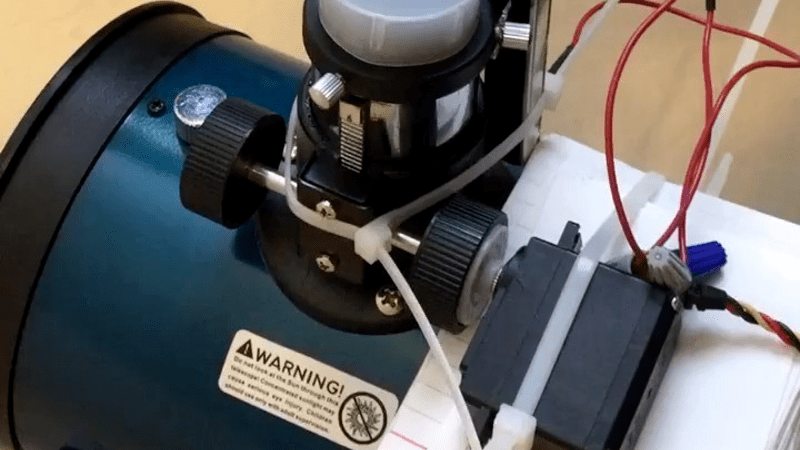Scanning the heavens with a telescope is a great way to spend long, clear winter nights, but using a manual telescope can get to be a drag. A motorized mount with altitude and azimuth control is basic equipment for the serious observer, but adding a servo to control the focus of your telescope is one step beyond your average off-the-shelf instrument.
Having already motorized the two axes of the equatorial mount of his modest telescope as a senior project, [Eric Seifert] decided to motorize the focus rack as well. His first inclination was to use a stepper motor like he did on the other two axes, but with a spare high-torque servo at hand, he hacked a quick proof-of-concept. The servo was modified for continuous rotation in the usual way, but with the added twist of replacing the internal potentiometer with an external linear pot. Attached to the focus tube, the linear pot allows [Eric] to control the position and speed of the modified servo. Sounds like controlling the focus will be important to [Eric]’s planned web interface for his scope; we’ll be looking for details on that project soon.
We like the simplicity of this solution, and it’s a trick worth keeping in mind for other projects. But if fancy steppers and servos aren’t your thing, fear not — astrophotography is as easy as slapping a couple of boards together with a hinge.
















Did the same thing years ago but simply used a fwd rev two way double switch. So it was only constant speed but plenty slow to get the focussing right. Just counted the seconds from it came into focus and went out of it again and then turned it back for half the number of seconds.
It will be interesting to see how this interfaces. The vast majority of computer control focus software using ASCOM rely on steppers moving past the critical focus point to draw a v curve, and then sending an instruction to step to the specific step of critical focus after. Hopefully he can interface this.
You could sweep the servo slow enough so you’re sure it’s in a certain position. I wonder if the servo is able to focus at just the right distance, if the resolution is high enough..
It’s more of a question for interfacing than anything electro/mechanical. The entire software toolchain used in astronomy is written for repeatable “steps”. Some translation would need to be done to linear movement so the computer would think it’s talking to a stepper.
He’s essentially implemented a remote focus control – a feature that would be required for any kind of auto-focus feature.
Also applicable to microscopes.
Pretty please with sugar on top, EDIT YOUR VIDEOS. This video was about three minutes too long.
Al;s: don’t record them on a boat when it’s stormy.
One thing worse than zip ties, un-clipped ones.
I’m going to assume the whole setup is experimental. Not just the zip-ties but the cardboard and shit to adjust it to the right height, it screams ‘temporary experiment’
His telescope isn’t on an equatorial mount. An equatorial (sometimes called polar) mount aligns a pivot axis parallel to Earth’s rotational axis. That way an object in space can be tracked as Earth rotates by simply moving a single axis of the mount in time with Earth.
Before fancy computer tracking systems, the tracking was done by clockwork mechanisms, especially when taking long exposure photos.
Even with computer tracking, equatorial mounts are better than altitude azimuth or Dobsonian mounts because the angle of the telescope relative to what it’s aimed at changes less. Not that it matters a lot with stars light years away, but there’s still less error with an equatorial mount.
Equatorial mounts are harder to set up, especially for portable telescopes, because the tracking axis has to be aligned perfectly.
Telescopes in space don’t have pointing angle problems like surface ones because they can continuously adjust their aim in all axes as they orbit around Earth or the Sun. That’s part of how distances to stars and other things are measured, by comparing parallax angles among various objects at different points in orbits around the Sun.
Are you getting paid for posting random stuff or something?
There are 24 hours in a day, in most places a day has a part where it’s light and one where it is dark.
A shower curtain has 12 rings to hang it on a horizontal pole.
When people discuss light in a semi-scientific discussion they seldomly touch on the critical concept of wavefronts.
In the last few years there has been a divergence between the winter weather in northern America and the weather in Europe at the same latitude.
Have you had a look at something like the HS-785HB Winch Servo Motor – Rotation = 1260 degrees (3.5 turns)
Much less messing around, but not sure it will have the resolution you need.
A steppers using micro stepping and/or reduction gear might be a better choice